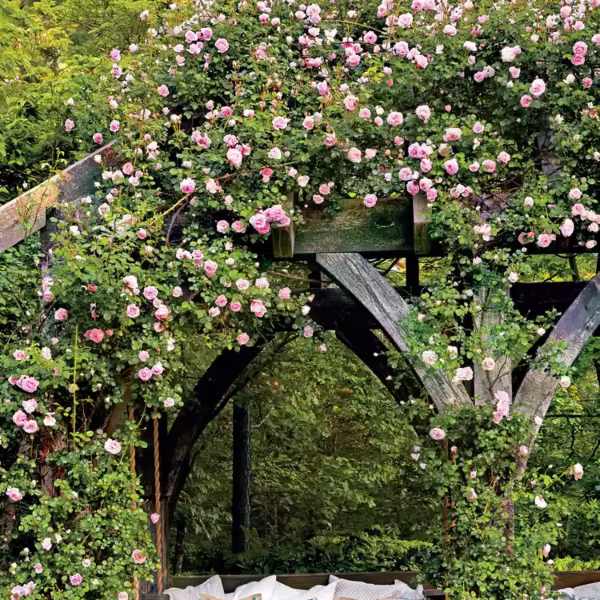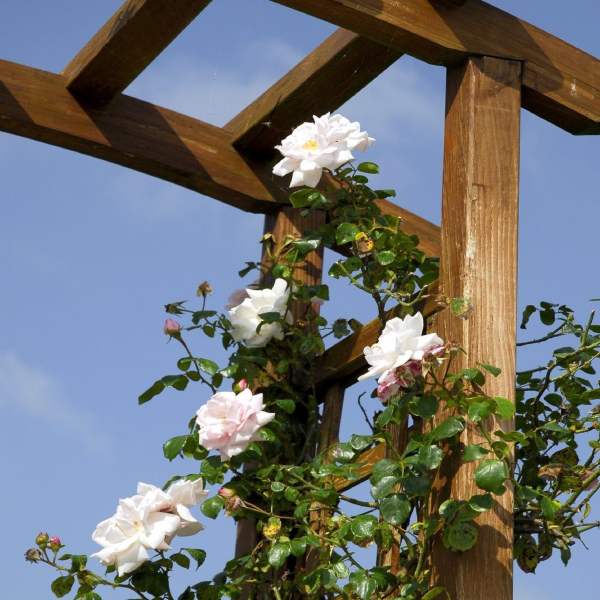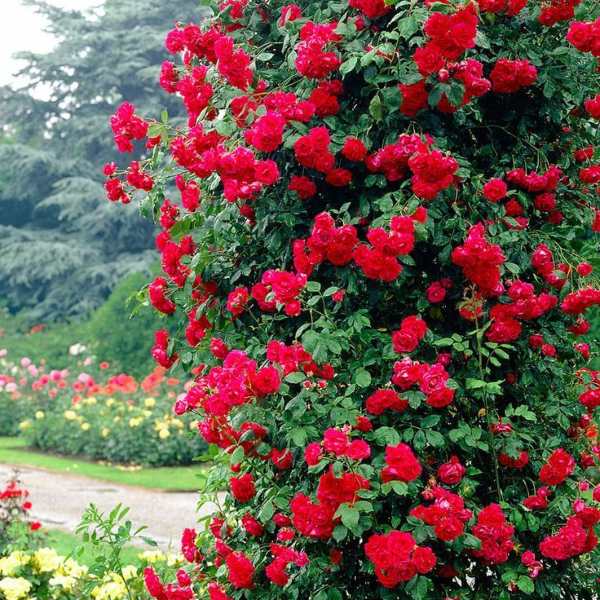If you love having flowers in your garden, it’s time for you to plant climbing roses (Rosa setigera) for a beautiful and dramatic element to it. These fellas are vigorous and relatively grow on a fence, ascend a trellis, drape over an arbor, or scramble up a tree when provided the support. Flowers grow on the end of the plant’s long canes in single flowers or a cluster of beautiful blooms. These roses are available in various colors and produce nice-smelling blooms when properly cared for throughout their blooming season.
Plant Attributes
- Common Name: Climbing Rose, Prairie Rose, Climbing Wild Rose
- Botanical Name: Rosa setigera
- Family: Rosaceae
- Plant Type: Perennial, Rose, Shrub
- Mature Size: 6-12 ft. tall, 3-4 ft. wide
- Sun Exposure: Full
- Soil Type: Loamy, Well-drained
- Soil pH: Acidic (6.0 to 6.5)
- Bloom Time: Summer, Fall
- Flower Color: Red, Pink, Orange, Yellow, White
- Hardiness Zone: Zones 5-9 (USDA)
- Native Area: North America

Also, Read The 20 Best, Easiest Houseplants That Can Be Grown in Any Home!
How to care for climbing roses?
While caring for climbing roses, it is necessary to note that these plants do not have twine or have suckers or tendrils to attach to a structure. That’s why you need to loosely secure the rose to a sturdy structure, such as a trellis or fence. We recommend you train them laterally rather than vertically for them to produce more blooms. If done, the plants will produce more buds since climbers will have short spurs along their central stems.
If possible purchase a climbing rose as a bare-root, dormant plant. This makes it much easier to handle the plant. Bareroot planting season starts in late winter or early spring when the soil is active and thawed. Planting at this time is perfect since it allows the roots to get established in their new home before the heat of summer arrives. Their roots develop faster in the fresh garden soil.
Light
All roses do best in full sun. While they can tolerate partial shade, they will thrive, bloom, and grow denser only when they receive at least four to six hours of direct sun each day. Pick a location that will house the climber’s growth habit.
Soil
While roses can adapt to various soil types, they work well in rich, fertile, loamy soil that has good drainage. Even if you do not have good soil, that is not a problem since you can always enhance it by adding organic matter such as compost, mulch, or peat. This will help with the drainage in heavy clay soil and produce more water retention in sandy soils.

Water
Watering climbing roses consistently, especially during the first year when roots are established is very important. They prefer regular, deep watering in the mornings. However, do not oversaturate the plants, making them susceptible to fungal diseases if the soil doesn’t drain properly.
Temperature and Humidity
Climbing roses love moderate temperatures between 50ºF and 80ºF. Areas with longer periods of extreme summer heat should plant these in places that provide partial afternoon shade. It is advisable to cover the plants after the first frost to protect them from the cold. Roses do well in relatively moderate humid environments.
Fertilizer
Like every other plant, climbing roses also need a lot of energy to produce. Fertilize regularly with a balanced fertilizer that gives ample amounts of all the required nutrients. Beware not to use fertilizers made for lawns which are very high in nitrogen. Fertilizers that have high nitrogen content will only produce a lush, dark green plant with fewer blooms.

Types of climbing roses
There are different varieties of climbing roses with different colors, sizes, and shapes. These versatile and easy-growing climbers are eye-catching and beautiful, adding charm to your garden. Here are some varieties for you to know:
- ‘New Dawn’: This soft pink flower with glossy foliage produces clusters of sweetly fragrant roses that can reach up to 15 feet.
- ‘Russell’s Cottage Rose’: A deep crimson flower, fading to pink, with fragrant foliage that grows around 10 to 20 feet.
- ‘Sombreuil’: This big creamy white bloom smells like a “Granny Smith” apple. Train this flower to climb a low wall, fence, or trellis, and watch how your garden just gets more beautiful.
- ‘Lady Banks’: A spring-blooming climbing rose available in yellow and white and can grow up to 20 feet.
- ‘Iceberg’: White to pink blooms produce clusters of medium-sized flowers with glossy leaves and easy-to-train climbing growth.
Pruning
Climbers normally require little or no pruning for the first two years. The majority of the older climbing varieties tend to bloom on second-year canes. Most climbing roses bloom at least twice each growing season; first on the older branches and then on the newer ones. If you thinking of pruning, do it in the dormant months of mid-to-late winter to produce enough late-season flowers. Also, remove any diseased, injured, or spindly branches. Cut off any old, woody canes that didn’t bloom in the previous season, and do not neglect any crossing or awkwardly placed branches.
Propagating climbing roses
Propagating climbing roses shouldn’t be a difficult task. You can do so by taking stem cuttings from blooms at least four to six inches in diameter in early autumn after the flowers have died. Here’s a step-by-step tips on how to propagate climbing roses from cuttings:
- Using sharp, sterile pruning shears, cut a cut six-to-eight-inch stem cutting from a healthy plant. The cut must be at a 45-degree angle to help the plant absorb moisture.
- Remove all including the outer bark from the angled-edge side of the cutting using a knife but not the top set of leaves. Do not cut into the stem.
- Fill a pot with moist potting soil. Using your hand or a pencil, create a hole in the center of the soil at least three inches deep.

- You can dip the cuttings in a rooting hormone( not mandatory) and plant the angeled-edge side of the cutting into the potting soil. Then lightly cover with soil around the cuttings.
- Keep the container in a bright, indirect light, and make sure to keep the soil consistently moist.
- After two sets of leaves grow and roots develop in about two months, move the cuttings to a place that gets plenty of morning sun. Do not place the plant in harsh afternoon sun until more mature.
- When spring arrives, move the climbing rose to its final location. If you live in dry climate regions, plant roses during the autumn after temperatures fall.
Common pests and diseases
Mostly, climbing roses are disease-resistant. However, they are still susceptible to certain fungal diseases like black spots, anthracnose, powdery mildew, and rust, often caused by too much water, humidity, and heat.
Insects like scales, aphids, whiteflies, and weevils occasionally attack climbing roses. You can simply treat small or infrequent infestations by spraying plants with a garden hose. If that doesn’t help, use insecticidal soap as directed. You can prevent pests by maintaining a healthy plant with full sun exposure and enough air circulation and by cutting off dead or damaged branches.
Common problems with climbing roses
Despite being easy and a great addition to gardens, climbing roses face some issues. You must know these to help promote better growth. Here’s what you should know about them:
Curling leaves
Climbing roses do network well in areas with sustained temperatures above 90°F. Extreme heat does not let the plant absorb nutrients and water. Avoid over-pruning to help care for plants and try planting in areas with afternoon shade. Extra coverings would benefit as they provide artificial shade during harsh sun exposure.

Leaves falling off
If you over-fertilize the plant, the foliage will die and fall off. Also, alkaline soils will discolor the plant’s foliage, turning it yellow or brown. You can add peat moss or mulch around the plant that can help it retain the ideal nutrients and absorb moisture.
FAQs
Q: What roses can be grown in Colorado?
A: The American Rose Society lists 48 classifications for roses. Roses in Colorado normally fall into one of the following types: hybrid tea, miniature, floribunda, grandiflora, climber, shrub (which includes English and Canadian roses), polyantha, and hybrid rugosa.
Q: Do thornless roses exist?
A: While not many, some thornless roses do exist. A number of them can be found which have scattered thorns along the stem. Roses like Polyanthas, tend to have fewer thorns as a class.
Also, Read 20 Plants That Thrive in Dry Conditions for Sandy Soil
